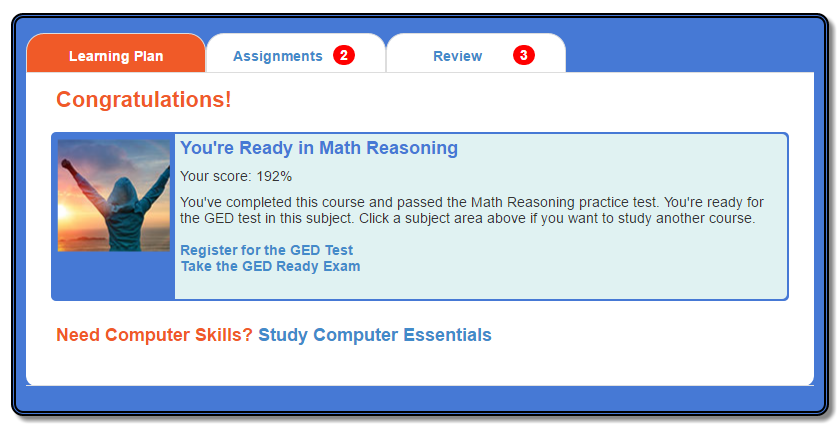
What do you need to know to pass the GED® Maths Test?
The GED® Mathematical Reasoning test is composed of two parts and it assesses a candidate’s problem solving skills, the ability to interpret charts, tables, and graphs and you must also demonstrate the ability to solve real life maths problems.
The test is 115 minutes and it is divided into two parts:
Part 1: 5 test questions. No calculator allowed
Part 2: 41 test questions. Calculator provided on-screen may be used where required.
Only the on-screen calculator may be used in the exam. You may not take your own.
The GED Math test contains the following:
- Number operations and number sense (20-30%)
- Measurement and geometry (20-30%)
- Data analysis, statistics, and probability (20-30%)
- Algebra, functions, and patterns (20-30%)
The test does not include trigonometry and there is also no calculus. You may not take a calculator or any personal belongings into the exam room. When calculations using a calculator are permitted, one is provided on-screen. You will also be given a formula sheet along with a white board and marker, which you can use for any rough calculations.
I have overcome my fear of Math thanks to the GED®. I passed it on my first attempt and that was a huge achievement for me.
Sai Pillay
The GED Math Tests two content areas:
- Quantitative Problem Solving (45%) – problems with positive and negative whole numbers, fractions, decimals, percentages, ratios, proportions, exponents, roots, data and statistics and geometric measurement
- Algebraic Problem Solving (55%) – includes equations, linear equations, quadratic equations, expressions, polynomials, , inequalities, patterns, graphs and functions. You will be tested on solving, and graphing skills in algebra.

The GED Maths tests is comprised of 5 types of questions:
- Multiple Choice
- Fill-in-the-blank
- Hot-spot
- Drag and drop
- Drop-down
To succeed on the GED® Math Test you need a strong grasp on problem-solving, reasoning and analytical skills. You must be able to draw and interpret information from both written and visual mathematical data. This may include diagrams, tables, graphs or charts. You must be able to understand and apply mathematical concepts in real-life contexts.
Passing the GED Math Test – as easy as ABC
A – Assessment
When a student first starts the Online GED Prep™ study programme, in each subject, the first thing they do is to take an assessment test of 30 questions. This determines at which level the student should begin and identifies skills which need to be developed.
Then, the student starts with some revision of basic concepts, in order to build a strong foundation. Concepts like
like whole numbers, fractions, percentages etc …which are junior school level maths lessons and mastering them quickly will encourage the student.
Students who have reached about year 11 or grade 10 level usually manage the GED® Maths very comfortably. Those who start at a lower level, take a wee bit longer to progress through the lessons as they need more practice in order to master the necessary skills. The Online GED Prep™ course is adaptive, which means it customises the lesson pathway to suit each individual learner’s needs.
B – Builds Builds Confidence
The benefit of this initial revision is twofold – firstly, it lays a firm foundation by filling in any ‘gaps’ in a student’s understanding of basic mathematical concepts and skills before tackling high school level maths.
Secondly, this revision and mastery of basics builds self-confidence. Many of our parents and students report that the healing of their self-esteem was an incredibly valuable part of the GED® course. They learned to believe that they could overcome challenges and be successful.
How the Online GED® Prep Course uses Positive Emotions to Optimise Learning
C- Customised
Students who grasp mathematical concepts quickly will be progressed through the lessons on a faster track than those who need additional practice and revision. This cuts boredom caused by unnecessary repetition for learners who are strong and ensures that those who need extra practice will get it.
Finally, the course is asynchronous, which means self-paced, so a student only progresses to the next lesson after mastering the new concept or skills in the current lesson.
This adaptive, individualised learning pathway is the online version of one-on-one tuition. Unlike a school classroom, where a class may move on to a new lesson before all the learners have mastered the last one, a learner controls his own rat of progress and can redo or revise any lesson or test he chooses. After completing the entire course, the student will receive a message on the screen that says:“Congratulations, you are ready in Math Reasoning,” as shown in the image below, if the student’s scores are good enough.

If the student has not scored well enough, then the message will be different. It will say “You are almost there, but first review the following lessons…” The lessons to review will appear on a list.
D – Dates are flexible
Since there are no fixed exam dates and no deadlines, students can choose their own test dates when they are confident that they are ready. The online study programme will show them when they have scored well and are likely to pass the test.
They can also first take a GED Ready® test. This is an optional half-length practice test, offered by the GED Testing Service. Contact us for information about that.
Being able to choose your own test dates to suit you takes away a load of stress. There is no pressure. A student can take as much time as they need to prepare. This helps them to not only master the skills they need, but build their confidence, develop a positive attitude and overcome their maths anxiety. The Online GED Prep™ sets them up for success!